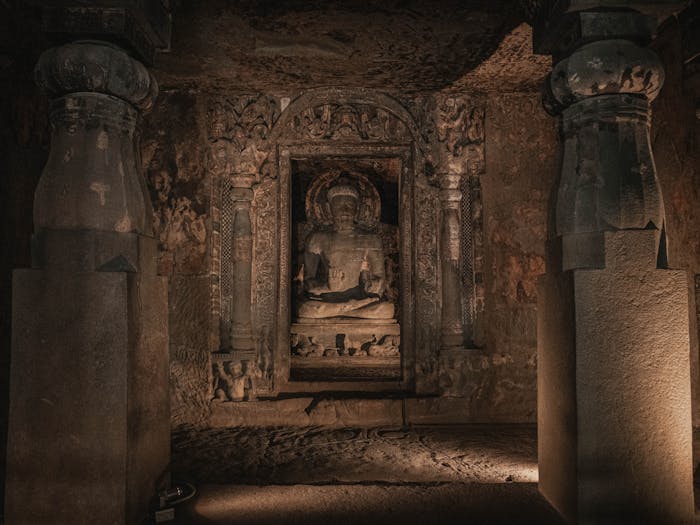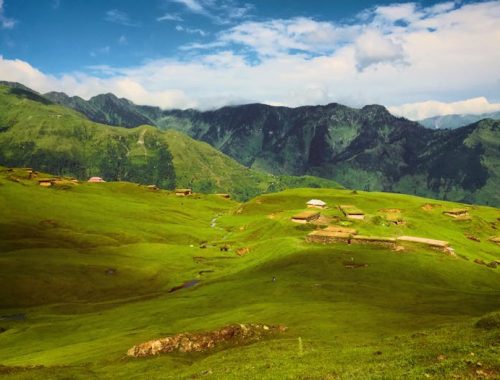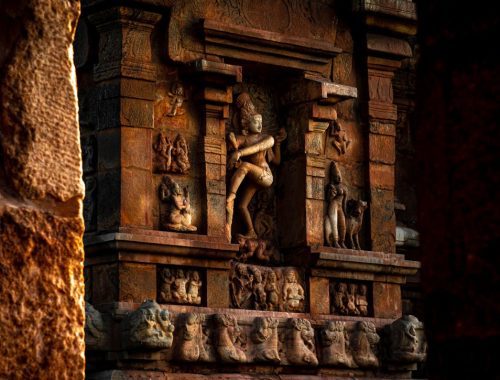
20 Must-Visit Caves in India for History and Culture Lovers
India is a country rich in history, culture, and diverse landscapes. It is home to some of the world’s most remarkable caves. These caves are not just natural wonders; they are a living proof of the country’s past, housing ancient art, scriptures, and architectural marvels. Whether you are a history enthusiast or a culture lover, these caves offer a unique glimpse into India’s fascinating heritage.
In this blog, we will explore 20 caves across India that every history and culture lover should visit at least once. Keep reading!
20 Must-Visit Caves in India
1. Ajanta Caves (Maharashtra)
Located in the state of Maharashtra, Ajanta Caves are a UNESCO World Heritage site. These 30 caves were carved between the 2nd century BCE and the 6th century CE and are famous for their stunning Buddhist murals and sculptures. The paintings inside the caves depict the life of Lord Buddha, offering a remarkable insight into ancient Buddhist culture.
Highlights:
- Buddhist murals and sculptures
- Ancient rock-cut architecture
- Rich historical and cultural significance
2. Ellora Caves (Maharashtra)
Just 100 kilometers away from Ajanta, the Ellora Caves are another UNESCO World Heritage site. They are a complex of 34 caves, dating back to between 5th and 10th centuries CE. The caves feature Hindu, Buddhist, and Jain temples, making them a remarkable showcase of India’s religious diversity.
Highlights:
- Kailasa Temple, a single monolithic structure
- Rock-cut temples dedicated to different religions
- Stunning carvings and sculptures
3. Elephanta Caves (Maharashtra)
The Elephanta Caves, located on Elephanta Island near Mumbai, are dedicated to Lord Shiva. These caves are famous for their colossal rock-cut sculptures, especially the 20-foot-high trimurti sculpture of Lord Shiva. The caves date back to the 5th to 8th centuries.
Highlights:
- Trimurti sculpture of Lord Shiva
- Rock-cut temples and caves
- Ancient Hindu art and architecture
4. Badami Caves (Karnataka)
Badami, once the capital of the Chalukya dynasty, is home to four temples carved into the cliffs of red sandstone. These caves, dating back to the 6th century, are an excellent example of early rock-cut architecture. The caves house both Hindu and Jain sculptures.
Highlights:
- Cave temples with Hindu and Jain carvings
- Picturesque views from the top
- Historical significance of the Chalukya dynasty
5. Bhedaghat Caves (Madhya Pradesh)
Located near the famous Bhedaghat waterfalls, these caves are carved out of limestone and are a perfect blend of nature and history. The caves are a popular tourist spot for their natural beauty and historical context.
Highlights:
- Limestone caves with unique formations
- Stunning natural beauty and waterfalls
- Rich in cultural significance
6. Kanha National Park Caves (Madhya Pradesh)
These caves are located within the dense forests of Kanha National Park, which is known for its wildlife. The caves are not only a natural wonder but also hold ancient carvings that tell stories of early human habitation.
Highlights:
- Ancient rock art
- Beautiful forested surroundings
- Historical significance
7. Meghalaya Caves (Meghalaya)
Meghalaya, also known as the “abode of clouds,” is home to several caves, including the Siju Caves, Liat Prah Caves, and Mawsmai Caves. These caves are known for their stunning stalactites and stalagmites formations, and they also hold religious significance.
Highlights:
- Limestone formations
- Spectacular stalactites and stalagmites
- Cultural importance to local tribes
8. Elephant Caves (Andhra Pradesh)
These ancient caves are located near the town of Anakapalle in Andhra Pradesh. The caves date back to the 3rd century BCE and are known for their rock-cut architecture and Buddhist shrines.
Highlights:
- Buddhist rock-cut shrines
- Ancient art and sculptures
- Stunning architecture
9. Kondana Caves (Maharashtra)
The Kondana Caves, located in the Western Ghats of Maharashtra, are an important Buddhist site. The caves, which date back to the 1st century BCE, are known for their intricate carvings and inscriptions.
Highlights:
- Ancient Buddhist inscriptions
- Scenic location in the Western Ghats
- Intricate rock carvings
10. Sanchi Caves (Madhya Pradesh)
The Sanchi Caves, located in Madhya Pradesh, are famous for their Buddhist stupas and ancient rock-cut caves. The site is actually a UNESCO World Heritage site and is known for its impressive sculpture work.
Highlights:
- Stupas and monolithic pillars
- Ancient Buddhist architecture
- UNESCO World Heritage site
11. Badami (Meghalaya)
Meghalaya is home to several caves that provide insight into ancient Indian history. These caves were used for meditation and worship. Known for their scenic beauty, they are great spots for history buffs and culture lovers.
Highlights:
- Historical significance to early Indian Buddhism
- Picturesque natural beauty
- Unique rock formations
12. Pataleshwar Caves (Maharashtra)
Located in Pune, the Pataleshwar Caves are dedicated to Lord Shiva. These caves are ancient rock-cut temples that date back to the 8th century and are known for their impressive rock carvings.
Highlights:
- Hindu rock-cut temples
- Intricate carvings dedicated to Lord Shiva
- Historical significance in Pune
13. Ranthambore Caves (Rajasthan)
The Ranthambore Caves, located in the famous Ranthambore National Park, are not only a wildlife haven but also home to ancient rock-cut temples and inscriptions. The caves are an important archaeological site.
Highlights:
- Ancient rock-cut temples
- Situated in the famous Ranthambore National Park
- Rich cultural heritage
14. Tungabhadra Caves (Karnataka)
These caves are located on the banks of the Tungabhadra River and are known for their intricate rock-cut architecture and sculptures. The caves are an essential part of Karnataka’s cultural history.
Highlights:
- Beautiful riverbank location
- Rock-cut temples and sculptures
- Historical significance to the Vijayanagara Empire
15. Meghalaya Caves (Mawsmai)
The Mawsmai Caves are one of the most famous caves in Meghalaya. Known for their limestone formations, these caves are a popular tourist destination and offer an exciting adventure for history and culture lovers.
Highlights:
- Limestone caves
- Adventurous caving experience
- Rich cultural history of the region
16. Varaha Caves (Madhya Pradesh)
Located near Ujjain, the Varaha Caves are ancient rock-cut temples dedicated to Lord Vishnu in his Varaha (boar) incarnation. These caves are an excellent example of ancient Indian architecture and religious practices.
Highlights:
- Ancient rock-cut temples
- Dedicated to Lord Vishnu
- Rich in religious history
17. Jain Caves (Gujarat)
The Jain Caves, located in Gujarat, are a fascinating example of Jainism’s influence in India. These caves are known for their exquisite carvings and provide a glimpse into Jain culture and art.
Highlights:
- Exquisite Jain carvings and temples
- A rich history of Jainism in India
- Peaceful and serene surroundings
18. Borra Caves (Odisha)
Located in the Eastern Ghats of Odisha, the Borra Caves are limestone caves famous for their stalactites and stalagmites formations. The caves are associated with the local tribal culture and offer stunning natural beauty.
Highlights:
- Limestone formations
- Rich tribal culture
- Scenic surroundings
19. Buddhist Caves (Ladakh)
Ladakh, a region known for its Buddhist culture, is home to several caves that were once used for meditation and worship. The caves in Ladakh offer a serene atmosphere and stunning views of the surrounding mountains.
Highlights:
- Buddhist meditation caves
- Stunning views of the Himalayan range
- Rich cultural and spiritual significance
20. Chopta Caves (Uttarakhand)
These ancient caves, located in the pristine landscapes of Chopta in Uttarakhand, have historical and spiritual significance. The caves are part of the region’s cultural heritage and are perfect for those looking for peace and solitude.
Highlights:
- Ancient spiritual caves
- Secluded and peaceful location
- Rich in cultural significance
Takeaway
India is home to a treasure trove of historical and cultural wonders, and its caves are a testament to the country’s rich heritage. From the Buddhist marvels at Ajanta and Ellora to the serene and secluded caves in the hills of Chopta, each cave tells a unique story. Whether you are an art lover, history enthusiast, or culture seeker, these 20 caves are must-visit destinations to explore India’s fascinating past. So pack your bags, put on your explorer’s hat, and set off on an adventure through India’s most captivating caves!
Khushi Jha
I am Khushi Jha, a proud alumna of Delhi University with a degree in History and Political Science. My fascination with the events that have shaped our world drives me every day. Currently, I am pursuing my Master’s in History, diving even deeper into global dynamics and the incredible heritage of India. I firmly believe that India's rich heritage deserves wider recognition. I strive to bring its stories to the forefront, ensuring they are celebrated and acknowledged on a global stage. I have written extensively across various niches, including fashion, health, lifestyle, real estate, hospitality, amongst others. In my free time, you’ll find me immersed in books, both fiction and non-fiction, or simply enjoying some much-needed rest.
You May Also Like

Kashmir Wants Tourists Back: A Fresh Travel Push Begins
May 21, 2025
BREAKING: Tamil Nadu Seeks ASI Approval to Excavate Seven Ancient Sites from Sangam and Chola Eras
August 24, 2025


